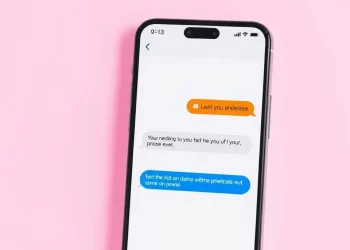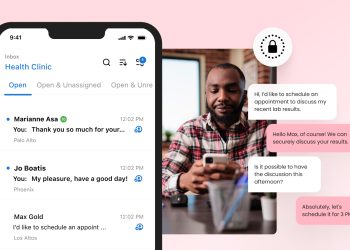Did you know that by 2023, businesses saved about 2.5 billion customer service hours with chatbots? This shows the transformative potential of AI conversational bots. They’re not just a future idea but a real tool for improving interaction and service. Experts are looking ahead to new service automation trends and the future of artificial intelligence assistants.
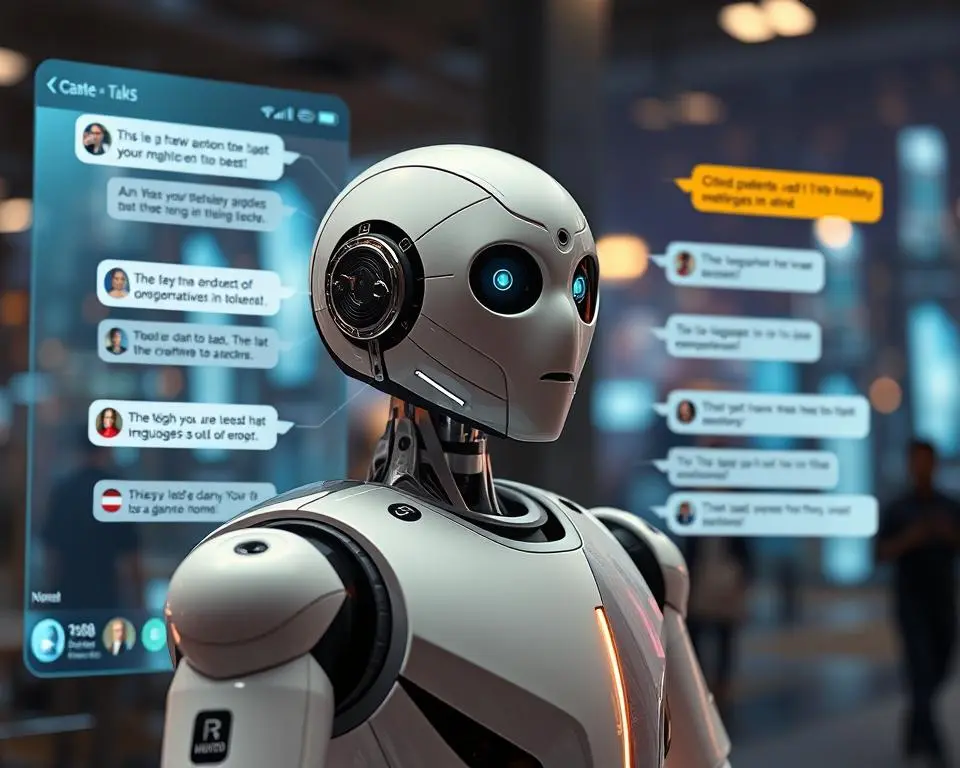
AI conversational bots are changing customer service, sales, and digital chats. They talk like humans, offering 24/7 help and quick answers. With advanced algorithms and deep learning, the future of artificial intelligence assistants is bright. This section will look at key trends and predictions for AI chat technologies.
Key Takeaways
- AI conversational bots are cutting down service hours and changing how we talk to customers.
- AI bots are growing fast, showing a big future for service automation.
- AI will keep changing and shaping the future of artificial intelligence assistants.
- Businesses need to watch AI trends to stay ahead in the digital world.
- Knowing the trends and predictions is key for companies using AI conversational bots.
Evolution of AI Conversational Bot Technologies
Chatbot technology has greatly changed from simple scripts to complex AI platforms. This change has changed how businesses and users talk to each other and made virtual assistant programs more advanced.
The Journey from Simple Scripts to Advanced AI
At first, chatbots followed simple rules and could only handle basic conversations. But then machine learning and advanced AI changed everything. Now, chatbots are smart, learning from what people say to give better service. They have turned into dynamic conversational AI platforms.
Impact of NLP and Machine Learning on Chatbots
Natural Language Processing (NLP) and machine learning are key to modern chatbots. They help chatbots better understand and respond to human language, making customer conversations with chatbots more natural and satisfying.
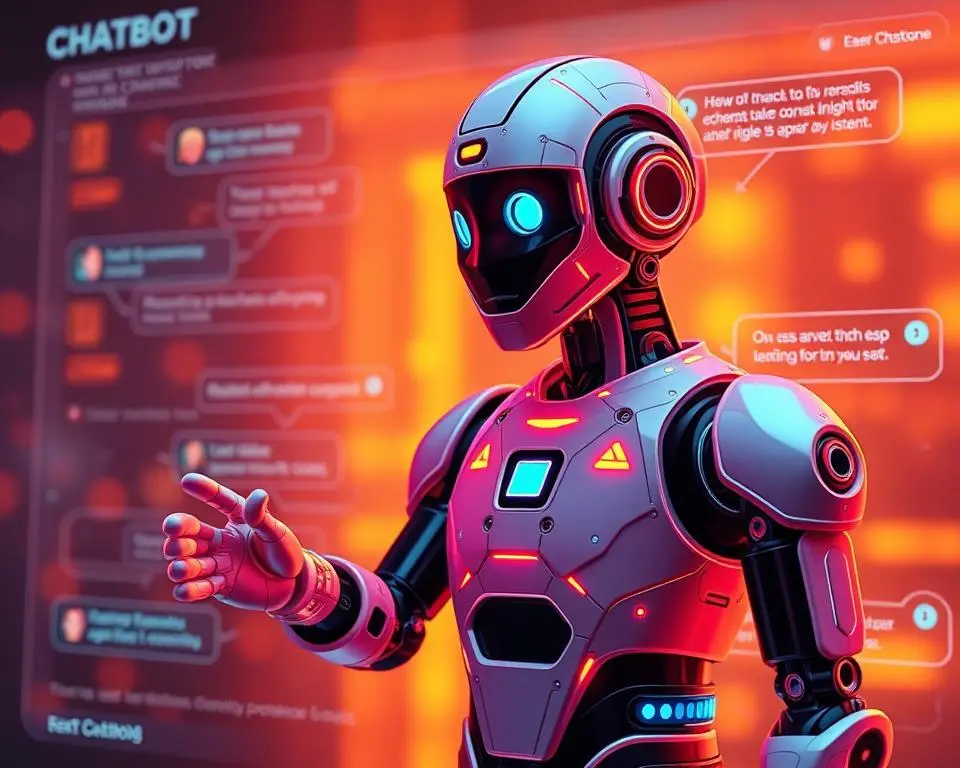
NLP turns simple questions into real conversations, making users feel understood. Machine learning makes chatbots smarter over time by learning from past conversations, making virtual assistant programs better at helping users.
In conclusion, chatbots have grown from simple programs to intelligent learning systems. This shows how AI has improved, making technology more connected and intuitive in many areas.
Enhancing User Experience Through Conversational AI
The use of intelligent virtual agents has changed how businesses talk to users. They focus on making the user experience better and providing support. With innovative chatbot solutions, companies can give faster, more personal help. They are also always available, making customers happier and more loyal.
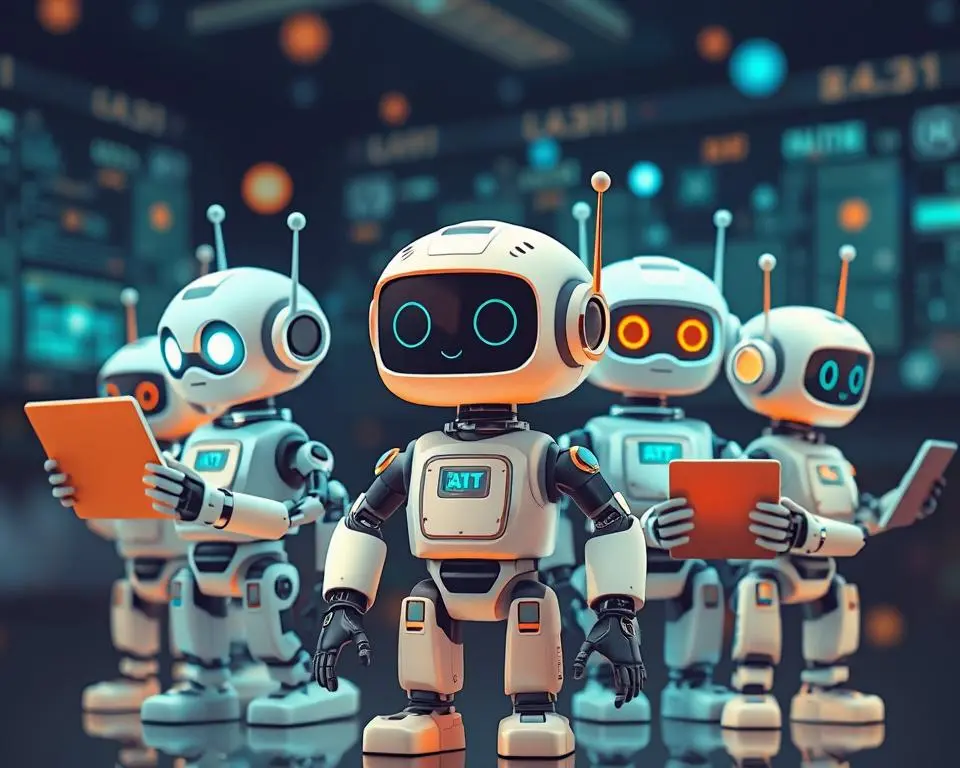
Conversational AI is great when you need quick and accurate information. These agents can understand and talk like humans, making it easy and fun for users to talk to them.
- Personalization of interactions based on user data
- Real-time support for customer queries
- Seamless integration with existing company systems
The table below shows how conversational AI is used in different areas. It shows how it makes things better for users.
| Industry | Application | Impact on User Experience |
|---|---|---|
| Retail | Product recommendations and support | Enhanced shopping experience with tailored suggestions and immediate assistance. |
| Finance | Transaction inquiries and financial advice | Simplified financial management with instant, personalized counsel and transaction handling. |
| Healthcare | Appointment scheduling and medical guidance | Improved patient care with quick appointment setting and accessible health information. |
| Education | Course information and administrative support | Streamlined educational experiences through easy access to course details and administrative help. |
A smart chatbot solution can learn and change over time. This makes it better at making things easier for users. As intelligent virtual agents improve, they can help more with customer service. This makes the digital world more connected and helpful.
The Emergence of AI Textor in Communication Platforms
In today’s fast-changing digital world, AI is key to improving how we talk to each other. AI Textor, a top-notch automated messaging system, leads this change. It shows how artificial intelligence can make communication smoother and more precise across different platforms.
Integrating AI Textor for Streamlined Communication and Customer Service
Adding Power Textor AI Textor to current communication systems is a big step forward. It improves how businesses talk to customers. This system fits companies’ unique needs, ensuring customers are happy and engaged. With its smart AI, AI Textor answers customer questions quickly and accurately, improving customer service.
Advancements in AI Responses with Company-Specific Documentation
AI Textor’s strength lies in using company-specific documentation for smart answers. This means businesses can give accurate and relevant info to customers. Using these databases cuts down on mistakes, making customer service more efficient.
The table below shows how AI Textor beats traditional customer service in efficiency and results:
| Feature | Traditional System | AI Textor System |
|---|---|---|
| Response Time | Minutes to Hours | Seconds to Minutes |
| Accuracy of Information | Varies Significantly | Highly Accurate |
| Personalization | Limited | High |
| Scalability | Low | High |
| Cost Efficiency | Medium | High |
Role of Machine Learning in Refining Chatbot Conversations
Machine learning has changed how businesses and customers talk to each other. It makes chatbots better at understanding and answering questions. This is thanks to adaptive learning and predictive conversations.
These features make chatbots more effective at talking to users.
Adaptive Learning for More Accurate Responses
Adaptive learning is key to chatbots’ evolution. It lets chatbots learn from past conversations and improve their answering skills. This means they get smarter with each chat and give more accurate answers.
This improves the user’s experience by giving them answers that are more relevant and appropriate to the situation.
Predictive Conversations: Anticipating User Needs
Predictive conversations are a new way chatbots work. They look at data to guess what users might ask next, allowing them to offer solutions before users even ask for them.
This makes talking to chatbots faster and more helpful. It also makes customers happier and more engaged.
| Feature | Benefits |
|---|---|
| Adaptive Learning | Customizes responses based on user history and preferences, improving accuracy and relevance. |
| Predictive Conversations | Anticipates user needs, allowing for quicker and more effective communication. |
AI Conversational Bot
The idea of an intelligent virtual agent is more than just automated answers. It’s a mix of AI technologies that act like humans in conversations. At its heart, a conversational bot uses AI to understand and answer questions in a way that feels real. Unlike old chatbots, these advanced agents use deep learning and natural language processing for more natural chats.
When we ask “is a chatbot artificial intelligence?” we see a big difference. All chatbots automate tasks, but not all use AI. A true AI chatbot learns from talks, changes its answers, and gets better over time. This makes the user experience richer and more responsive.
- Natural Language Understanding (NLU)
- Natural Language Generation (NLG)
- Machine Learning Models
An intelligent virtual agent uses these elements to do more than just follow scripts. It can guess what users need, understand the context, and answer with empathy and understanding, just like a human.
| Feature | Benefits |
|---|---|
| Multilingual Capabilities | Helps businesses work globally, offering support in many languages without needing more staff. |
| 24/7 Availability | Increases customer happiness with always available help, solving problems and questions immediately. |
| Data Handling | Gathers and analyzes data from chats, giving insights into what customers like and prefer. |
In conclusion, the role of an intelligent virtual agent in AI is key. An AI conversational bot can give personalized experiences beyond what users expect. It sets a new high for how companies talk to customers.
Breaking Down the AI Chatbot Versus Conversational AI Debate
In today’s world, “chatbot” and “conversational AI” are often mixed up, but they mean different things. Knowing the difference between chatbot and conversational AI shows how AI changes how we talk to machines.
Defining the Distinctions: Chatbot vs. Conversational AI
It’s key to understand what makes a chatbot and conversational AI different. Chatbots are simple systems that give set answers to certain questions. On the other hand, conversational AI uses advanced tech like NLP and machine learning to understand and respond to human talk.
Use Cases of AI-Powered Conversation Agents
Conversational AI is great at giving innovative and context-aware talks. It’s really useful in many areas. Here are some places where AI chat agents are making a big difference:
- Customer Service: They automate answers and handle common questions, making things run smoother.
- Healthcare: They help with patient care by setting up appointments, providing health information, and reminding patients about medications.
- E-commerce: They guide shoppers through buying, suggest items based on what they bought before, and help with returns.
- Banking: They let you do secure transactions with voice commands and give real-time financial advice.
These examples show how conversational AI is better than chatbots in many ways. It helps businesses and customers a lot.
| Feature | Chatbot | Conversational AI |
|---|---|---|
| Technology Base | Rule-based programming | NLP and machine learning |
| Interaction Type | Limited, pre-defined scripts | Dynamic, context-aware dialogue |
| Learning Capability | None | Continuous from interactions |
| Implementation Cost | Lower | Higher due to advanced technology |
The Integration of Voice Assistants and Chatbot Technology
The world of voice assistants and chatbot conversational systems has changed how we talk to technology. Now, we can use our voices to interact, making things easier and more natural. This change brings us closer to a future where tech fits into our daily talks.
At the heart of this change are smart chatbots and top-notch voice recognition. These voice assistants are making life easier by letting us control things without using our hands. They also help make technology available to everyone, including those with special needs.
These systems do more than answer simple questions. They understand the context, tone of voice, and even body language. With every chat, they better know what we need, making our conversations more personal and valuable.
- Incorporation of machine learning to fine-tune responses based on user interaction history.
- Voice-activated functionalities that enable control over home automation systems, providing a hands-free user experience that emphasizes convenience and efficiency.
- Enhanced accessibility features assist users with visual impairments or motor limitations, offering them a more autonomous way to interact with technology.
The blend of voice assistants and chatbot conversational tech is a big step towards more caring digital tools. It shows us a new way of talking to machines, leading to deeper and more meaningful conversations.
Challenges and Ethical Considerations in AI Bot Development
AI technologies are getting better, but they also bring big ethical challenges. These challenges concern how these systems are made and used in real life. We worry a lot about privacy, security, and making sure AI is fair and unbiased.
Maintaining Privacy and Security in Conversational Platforms
AI chat platforms deal with much personal data, a big worry. They use a lot of data, including what users share, so keeping this data safe is key. This makes users trust the system more and ensures it follows the rules of data protection worldwide.
Addressing Bias and Fairness in AI Responses
AI bots also face the challenge of avoiding bias. Ensuring AI doesn’t show bias is essential to avoid unfair treatment. To fix this, AI training must often be updated to include a wide range of people.
| Challenge | Current Best Practices | Impact on User Trust |
|---|---|---|
| Privacy and Security | End-to-end encryption, Regular data audits | Increases user confidence and system reliability |
| Bias and Fairness | Inclusive data sets, Algorithm auditing | Prevents discrimination and enhances service equity |
Conversational Bots as a Tool for Inclusivity and Accessibility
Technology is improving, making it easier to use conversational bots for inclusivity and accessibility with AI. These AI tools are changing how we get customer service. They also help people with disabilities or those who can’t easily use regular services.
Developers are making sure these bots work for everyone. This means people with different abilities can use technology in a way that matters to them. For example, voice-activated bots help people who can’t see well, and text-based chat helps those who have trouble hearing.
- Incorporation of adaptive text sizes and contrast settings for users with visual impairments.
- Speech-to-text functionalities enable those with limited manual dexterity to engage effectively.
- Natural language processing allows users with cognitive disabilities to receive clearer and more contextual interactions.
AI is making a big difference in this area. It’s not just about following accessibility rules. It’s about making technology work better for everyone. This change makes services more available to more people in our digital world.
As these technologies improve, conversational bots will be key to making AI more universal. This is a big change in how we use technology every day, making sure no one is left out in the digital age.
Conclusion
AI conversational bots have shown great potential in our examination of their current state and future. Thanks to machine learning and natural language processing, they’ve moved from simple scripted talks to complex chats. These advanced systems improve user experiences and are becoming key to making customer service more efficient, friendly, and quick.
The future of AI assistants looks bright as they grow. They’re changing how businesses talk to their customers. With voice assistants and AI’s ability to learn, every chat can teach and improve. But, we must tackle issues like data privacy, security, and AI bias to ensure they grow correctly.
AI conversational bots offer growth opportunities and better customer service across all industries. Looking ahead, using these AI tools smartly will lead to new innovations and set new standards for how companies talk to customers. Companies ready to use these smart systems will lead the customer service revolution. They’ll boost their efficiency and make customers happier.
FAQ
How are AI conversational bots transforming customer interactions?
AI conversational bots are changing how we talk to customers by offering help immediately. They make services faster and more personal, making it easier for customers to get help whenever needed.
What has been the evolution of chatbot technology and how has it impacted interactions?
Chatbots started as simple machines that provided answers. Today, they’re smart enough to understand what we say and respond like real people, making talking to them much more natural and helpful.
How does conversational AI improve user experience?
Conversational AI gives us smart helpers that know what we need. They use our history to give us the right answers, ensuring we’re always supported. This makes customers happier and more satisfied.
What is AI Textor, and how does it benefit businesses?
AI Textor is a new way to improve company messaging. It uses company information to give precise answers, improving and personalizing customer service.
What role does machine learning play in refining chatbot conversations?
Machine learning helps chatbots improve their communication skills. They learn from what we say to give better answers, which means they can guess what we need before we ask.
How does an AI conversational bot differ from a traditional chatbot?
AI conversational bots are way more advanced than old chatbots. They can understand complex talks and adapt to what we say. They also make decisions on their own, making conversations feel more real.
Can you define the distinction between chatbot and conversational AI?
The main difference is how complex they are. Chatbots are simple and follow a script, but conversational AI is advanced, understanding and responding to our needs in a more human-like way.
How are voice assistants being integrated with chatbot technology?
Voice assistants are being added to chatbots to make talking to them easier. Now, we can use voice commands for help, which is great for people who prefer talking or have trouble seeing.
What are some of the challenges and ethical considerations in AI bot development?
Making AI bots is tricky because we have to keep user information safe and ensure they’re fair. Developers must follow the rules to avoid using data wrongly or unfairly.
In what ways do conversational bots promote inclusivity and accessibility?
These bots help everyone by offering support to more people, including those with disabilities. They’re designed to be easy for everyone to use, ensuring no one is left out.


